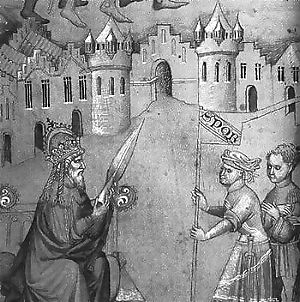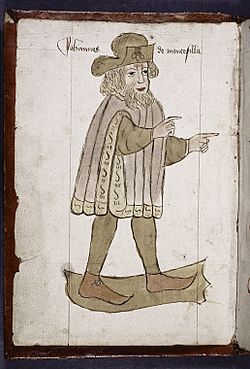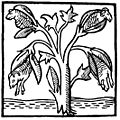John Mandeville facts for kids
Sir John Mandeville is the supposed author of The Travels of Sir John Mandeville, a travel memoir which first circulated between 1357 and 1371. The earliest surviving text is in French.
By aid of translations into many other languages, the work acquired extraordinary popularity. Despite the extremely unreliable and often fantastical nature of the travels it describes, it was used as a work of reference: Christopher Columbus, for example, was heavily influenced by both this work and Marco Polo's earlier Travels.
Contents
Authorship
In the preface, the compiler calls himself a knight, and states that he was born and bred in England, in the town of St Albans. Although the book is real, it is widely believed that "Sir John Mandeville" himself was not. Common theories point to a Frenchman by the name of Jehan à la Barbe.
Some more recent scholars have suggested that Mandeville's Travels was most likely written by Jan de Langhe, a Fleming who wrote in Latin under the name Johannes Longus and in French as Jean le Long. Jan de Langhe was born in Ypres early in the 1300s and by 1334 had become a Benedictine monk at the abbey of Saint-Bertin in Saint-Omer, which was about 20 miles from Calais. After studying law at the University of Paris, Langhe returned to the abbey and was elected abbot in 1365. He was a prolific writer and avid collector of travelogues, right up to his death in 1383.
Contemporary corroboration
At least part of Mandeville's Travels and the life of John Mandeville is mere invention. No contemporary corroboration of the existence of such a Jehan de Mandeville is known. Some French manuscripts, not contemporary, give a Latin letter of presentation from him to Edward III of England, but so vague that it might have been penned by any writer on any subject.
Compilation is thought, in large part, to have come from a Liège physician known as Johains à le Barbe or Jehan à la Barbe, otherwise Jehan de Bourgogne. Evidence for this comes from a modernized extract quoted by the Liège herald, Louis Abry (1643–1720), from the lost fourth book of the Myreur des Hystors of Johans des Preis, styled d'Oultremouse. In this, "Jean de Bourgogne, dit a la Barbe" is said to have revealed himself on his deathbed to d'Oultremouse, whom he made his executor, and to have described himself in his will as "messire Jean de Mandeville, chevalier, comte de Montfort en Angleterre et seigneur de l'isle de Campdi et du château Pérouse (Lord Jean de Mandeville, knight, Count de Montfort in England and lord of the Isle of Campdi and the castle Pérouse)".
It is added that, having had the misfortune to kill an unnamed count in his own country, he engaged himself to travel through the three parts of the world, arrived at Liège in 1343, was a great naturalist, profound philosopher and astrologer, and had a remarkable knowledge of physics. The identification is confirmed by the fact that in the now destroyed church of the Guillemins was a tombstone of Mandeville, with a Latin inscription stating that he was otherwise named "ad Barbam", was a professor of medicine, and died at Liège on 17 November 1372: this inscription is quoted as far back as 1462.
Even before his death, the Liège physician seems to have confessed to a share in the circulation of, and additions to, the work. In the common Latin abridged version of it, at the end of c. vii., the author says that when stopping in the sultan's court at Cairo he met a venerable and expert physician of "our" parts, but that they rarely came into conversation because their duties were of a different kind, but that long afterwards at Liège he composed this treatise at the exhortation and with the help (Jiortatu et adiutorio) of the same venerable man, as he will narrate at the end of it.
And in the last chapter, he says that in 1355, on returning home, he came to Liège, and being laid up with old age and arthritic gout in the street called Bassesavenyr, i.e. Basse-Sauvenière, consulted the physicians. That one came in who was more venerable than the others by reason of his age and white hairs, was evidently expert in his art, and was commonly called Magister Iohannes ad Barbam. That a chance remark of the latter caused the renewal of their old Cairo acquaintance, and that Ad Barbam, after showing his medical skill on Mandeville, urgently begged him to write his travels; "and so at length, by his advice and help, monitu et adiutorio, was composed this treatise, of which I had certainly proposed to write nothing until at least I had reached my own parts in England". He goes on to speak of himself as being now lodged in Liège, "which is only two days distant from the sea of England"; and it is stated in the colophon (and in the manuscripts) that the book was first published in French by Mandeville, its author, in 1355, at Liège, and soon after in the same city translated into "said" Latin form. Moreover, a manuscript of the French text extant at Liège about 1860 contained a similar statement, and added that the author lodged at a hostel called "al hoste Henkin Levo": this manuscript gave the physician's name as "Johains de Bourgogne dit ale barbe", which doubtless conveys its local form.
Contemporary mention
There is no contemporary English mention of any English knight named Jehan de Mandeville, nor are the arms said to have been on the Liège tomb like any known Mandeville arms. However, George F. Warner has suggested that de Bourgogne may be a certain Johan de Bourgoyne, who was pardoned by parliament on 20 August 1321 for having taken part in the attack on the Despensers (Hugh the Younger and Hugh the Elder), but whose pardon was revoked in May 1322, the year in which "Mandeville" professes to have left England. Among the persons similarly pardoned on the recommendation of the same nobleman was a Johan Mangevilayn, whose name appears related to that of "de Mandeville", which is a later form of "de Magneville".
The name Mangevilain occurs in Yorkshire as early as the 16th year of the reign of Henry I of England, but is very rare, and (failing evidence of any place named Mangeville) seems to be merely a variant spelling of Magnevillain. The meaning may be simply "of Magneville", de Magneville; but the family of a 14th-century bishop of Nevers were called both "Mandevilain" and "de Mandevilain", where Mandevilain seems a derivative place-name, meaning the Magneville or Mandeville district. The name "de Mandeville" might be suggested to de Bourgogne by that of his fellow culprit Mangevilayn, and it is even possible that the two fled to England together, were in Egypt together, met again at Liège, and shared in the compilation of the Travels.
Whether after the appearance of the Travels either de Bourgogne or "Mangevilayn" visited England is very doubtful. St Albans Abbey had a sapphire ring, and Canterbury a crystal orb, said to have been given by Mandeville; but these might have been sent from Liège, and it will appear later that the Liège physician possessed and wrote about precious stones. St Albans also had a legend, recorded in John Norden's Speculum Britanniae (1596) that a ruined marble tomb of Mandeville (represented cross-legged and in armour, with sword and shield) once stood in the abbey; this may be true of "Mangevilayn" or it may be apocryphal. T
Contents

According to the book, John de Mandeville crossed the sea in 1322. He traversed by way of Turkey (Asia Minor and Cilicia), Tartary, Persia, Syria, Arabia, Egypt, Libya, Ethiopia, Chaldea, Amazonia, India and many countries about India. He had often been to Jerusalem, and had written in Romance languages as they were generally more widely understood than Latin.
See also
 In Spanish: Juan de Mandeville para niños
In Spanish: Juan de Mandeville para niños
- Menocchio
Images for kids
-
Cotton plant as imagined and drawn by John Mandeville; "There grew there [India] a wonderful tree which bore tiny lambs on the endes of its branches. These branches were so pliable that they bent down to allow the lambs to feed when they are hungrie."




